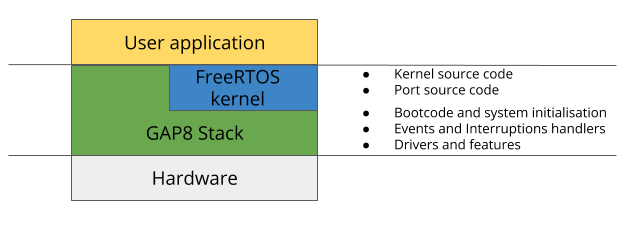 |
FreeRTOS port on GAP8/RISC-V
|
 |
 |
FreeRTOS port on GAP8/RISC-V
|
 |
Allocate memory from an allocator.

FreeRTOS is an RTOS designed for small and resource constrained micro-controllers, issued under MIT license. It was developed and maintained, since 2003, by Richard Barry and his Real Time Engineers Ltd. It is now under the aegis of Amazon Web Services and became Amazon FreeRTOS since 2017. FreeRTOS still remains available under MIT license. Light and easily configurable, it supports multi-tasking, various synchronization mechanism and communication between tasks, and various others features. You may refer to the official website to learn more about FreeRTOS and its features.
```bash freeRTOS ├── demos | └── gwt — "Hello World" demo ├── freertos_kernel — FreeRTOS kernel source code | ├── include — FreeRTOS kernel headers and macros | ├── License — FreeRTOS License file | └── portable — FreeRTOS port source files └── vendors — Vendors specific drivers and libraries └── gwt ```
FreeRTOS is a small kernel for embedded systems. To make use of GAP8 and GAPUINO, a stack has been added between the kernel and the hardware as follows.

The GAP8 stack makes use of PMSIS_API.
The port essentially concerns 3 files : ```bash /gap_sdk/rtos/freeRTOS$ tree freertos_kernel/portable/GCC/RI5CY-GAP8/ freertos_kernel/portable/GCC/RI5CY-GAP8/ ├── chip_specific_extensions — RISC-V chips extensions definitions and macros │ └── gap8 — GAP8 extensions │ └── freertos_risc_v_chip_specific_extensions.h ├── port_asm.S — Functions written in RISC-V assembly ├── port.c — Functions needed for the port └── portmacro.h — macros used for the port ```
In demos folder, there is a simple there is a simple "Hello World" example for FreeRTOS. Before trying this example, the shell environment shall be configured. To do so, start a terminal and navigate to gap_sdk folder and then execute source command. When prompted, select GAP8(1) or GAP8_V2(2) : ```bash /gap_sdk$ source sourceme.sh Which chip you want to use: 1-GAP8 2-GAP8_V2 [1]: 1 The target chip you have chosen is : GAP8 ```
Then navigate to the 'HelloWorld' demo and execute the following command : ```bash /gap_sdk$ cd freeRTOS/demos/gwt/gap8/common/application_code/ /gap_sdk/freeRTOS/demos/gwt/gap8/common/application_code$ make clean all run ```
You should get this as the output
```c /* PMSIS includes */ #include "pmsis.h"
/* Variables used. */ PI_L2 char hello[20];
void helloworld(void) { printf("Entering main controller\n"); uint32_t errors = 0; uint32_t core_id = pi_core_id(), cluster_id = pi_cluster_id();
sprintf(hello, "[%d %d] Hello World!\n", cluster_id, core_id); printf(hello);
pmsis_exit(errors); }
/* Program Entry. */ int main(void) { printf("\n\n\t *** FreeRTOS HelloWorld *** \n\n"); return pmsis_kickoff((void *) helloworld); } ```
This helloworld example has 2 functions : main() and helloworld(). The main() function is used to create threads, kernel objects(semaphore, mutex,...), and start the scheduler. Once the scheduler has started, there is no return to the main() function. Therefore, if you need to share variables or objects between tasks, do not instantiate inside the main() function. helloworld() is the actual function printing "Hello World". The created task's core function.
configMINIMAL_STACK_SIZE is used to indicate the minimal stack size for the Idle Task(task with the lowest priority, 0). Stack overflow can be checked during runtime by the kernel if configCHECK_FOR_STACK_OVERFLOW is set in FreeRTOSConfig.h. If configCHECK_FOR_STACK_OVERFLOW is set, a hook function must be defined by the user. The released FreeRTOS is set to check overflows and the associated hook function is defined in FreeRTOS_util.c. The program is terminated in case of stack overflow. You are free to edit it to suit your application.configMAX_PRIORITIES - 1.Task handler is always linked to a task. It can be used to stop, resume or kill a task by another one.More details on task creation are available here and FreeRTOS API Reference.
If the task creation is successful, the scheduler can then be called. From here on, the main() function is not reachable.
In vTestHelloWorld(), the task prints "Hello World" with its name, core ID and cluster ID. When it is done, the task suspends its execution( vTaskSuspend( NULL ) ) and the Idle task takes place on the core and cleans memory allocated for the deleted task. When a task is deleted using vTaskDelete( taskHandle ), the Idle task must not be starved of processing time to free allocated memory. The Idle Task hook should not use any blocking API.
In the released FreeRTOS, Idle Task hook is used to get details of tasks or delete suspended tasks. Once again, you may edit FreeRTOS_util.c to your convenience.
Console through uart will be triggered by flag PRINTF_UART, which should be add in the user makefile:
```bash FREERTOS_FLAGS += -DPRINTF_UART=1
APP_CFLAGS += -DPRINTF_UART=1 ```
Tasks in FreeRTOS are classified in 4 states :
vTaskDelay() function, or if a non-null timeout has been defined when the task was waiting for a semaphore, mutex or queue and is not yet available. If the timeout is reached and the object is not available, the task enters in Ready state.vTaskSuspend() and xTaskResume() are the API calls to get in and out of this state.The states transition diagram is given below.

.
FreeRTOS scheduler is preemptive, with Round-Robin policy. User can modify its behaviour with configUSE_PREEMPTION and configUSE_TIME_SLICING, FreeRTOSConfig.h.
configUSE_PREEMPTION = 0 :taskYIELD()configUSE_PREEMPTION = 1 :configUSE_TIME_SLICING = 0 :
Preemptive mode enabled without time slicing, i.e processing time(quantum) will not be equal between tasks. Tasks are preempted from the core if
taskYIELD()configUSE_TIME_SLICING = 1 :
Preemptive mode enabled with time slicing, i.e equal processing time between tasks of equal priority. Tasks are preempted from the core if
taskYIELD()FreeRTOS is released with preemptive mode and time slicing enabled.
On GAP8, there are 3 locations for data storage :
| Name | Address | Size | Type |
|---|---|---|---|
| L2_RAM | 0x1C000000 | 512kB | Primary memory used for both data and instructions storage |
| FC_TCDM | 0x1B000000 | 16kB | Memory used by Fabric Controller for fast access |
| L1_TCDM | 0x10000000 | 64kB | Shared memory between Feature Cluster cores |
FreeRTOS offers 5 algorithms to allocate memory.
configSUPPORT_DYNAMIC_ALLOCATION must be set in order to use the following malloc implementations.
pvPortMalloc( size ), malloc function. The requirements to use this implementation : memory size, defined with configTOTAL_HEAP_SIZE, and an array for the heap if configAPPLICATION_ALLOCATED_HEAP is set. This implementation allows memory allocation but does not allow to free the allocated memory.vPortDefineHeapRegions( xHeapRegions ) function. In main(), this call should be the first instruction, before task creation.In order to optimize memory allocations, we have added our own memory allocation implementation. You can find it in rtos/pmsis/pmsis_driver/pmsis_malloc/malloc_internal.c. It is a simple allocator which do not keep metadata used to allocate memory. Therefore this implementation requires, to free an allocated memory block, a pointer to the block to free along with its size.
```c /*!
| a | Pointer to a memory allocator. |
| size | Size of the memory to be allocated. |
| a | Pointer to a memory allocator. |
| _chunk | Start address of an allocated memory chunk. |
| size | Size of the allocated memory chunk. */ void __malloc_free(malloc_t *a, void *_chunk, int32_t size); ``` All three memory allocation(in memory locations previously mentionned) strategies rely on this implementation. |
In GAP8, it is possible to allocate memory in each of the 3 memory locations.
| Location | Function | Arg | Type |
|---|---|---|---|
| L2_RAM | void pmsis_l2_malloc() | int size | Allocate a chunk of *size bytes in L2 and returns a pointer |
| L2_RAM | void pmsis_l2_malloc() | void *_chunk, int size | Free an allocated memory chunk |
| FC_TCDM | void pmsis_fc_tcdm_malloc() | int size | Allocate a chunk of *size bytes in FC memory and returns a pointer |
| FC_TCDM | void pmsis_fc_tcdm_malloc_free() | void chunk, int size | Free an allocated memory chunk. |
| L1_TCDM | void *pmsis_l1_malloc() | int size | Allocate a chunk of *size bytes in shared L1 memory and returns a pointer |
| L1_TCDM | void *pmsis_l1_malloc_free() | void *chunk, int size | Free an allocated memory chunk. |
Few notes :
pmsis_l2_malloc_init(heapstart, size) for instance, which takes an address to heap and the size of the heap). This initialization is already done by default.FC_TCDM or L2_RAM depending on available heap. This implementation is more standard like. It tries to allocate in FC_TCDM first then in L2_RAM.```c /*!
| size | Size of the memory to be allocated. |
| _chunk | Start address of an allocated memory chunk. */ void pmsis_malloc_free(void *_chunk); ``` |
GAP8 possess a DMA to transfer data between IO peripherals and 'L2_RAM', called UDMA, as you can see on the picture above. There is a limitation to the UDMA usage : the data buffer to send to peripherals or to retrieve data from peripheral can only be in L2_RAM. Thus if you need to send or receive data from IO peripherals, you have to use pmsis_l2_malloc() explicitly in order to make sure the allocated buffer is in L2_RAM. There is also the simpler option to have the buffer in L2 memory by declaring it as a global variable(since global variables are by default in L2_RAM).
| Type | Size | Location |
|---|---|---|
| Cluster Task Stack | 1KB | L1_TCDM |
| Main Stack | 4KB | FC_TCDM |
| ISR Stack | 1KB | FC_TCDM |
| Idle Task Stack | 512B | L2_RAM |
| FC Task Stack | User choice | L2_RAM |
Main Stack refers to the stack allocated for the main() function only. In FreeRTOS, when tasks are created and the scheduler called, there is no coming back to this function, meaning the stack can also not be accessed. If variables/objects are to be passed to tasks, consider using global variables or dynamically allocate them in L2.
For each created task, a memory chunk is allocated in L2_RAM, with th size depending on task's function. This is the FC Task Stack. When a part of the task is executed on the Cluster, then for each core enabled, 1KB memory is allocated in L1_TCDM(Cluster Task Stack).
In this release, kernel is configured as follows :
All the other configurations are in FreeRTOSConfig.h, you can edit it to suit your application.
Hook functions and memory regions are defined in FreeRTOS_util.c and FreeRTOS_util.h.
More details and information are available in Amazon Reference Manual and in FreeRTOS Kernel Configuration.
Documentation and API Reference can be found on FreeRTOS API Reference, Amazon Reference Manual or Amazon Developer Guide.